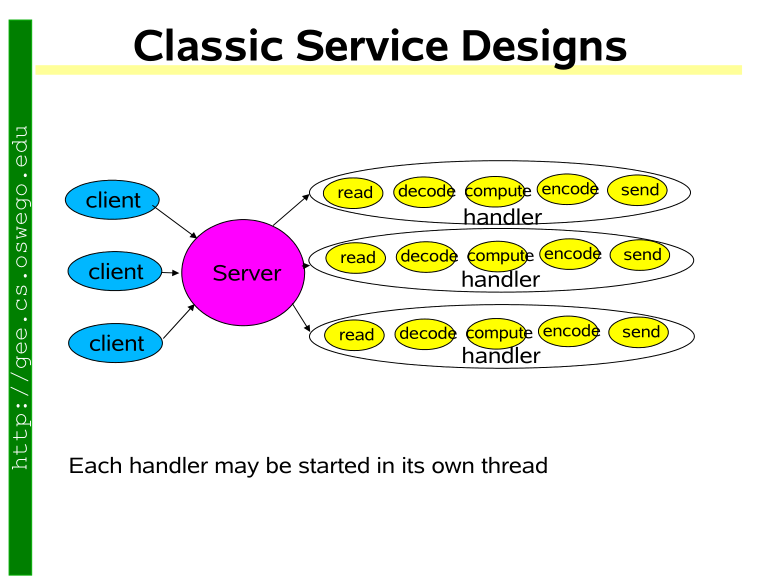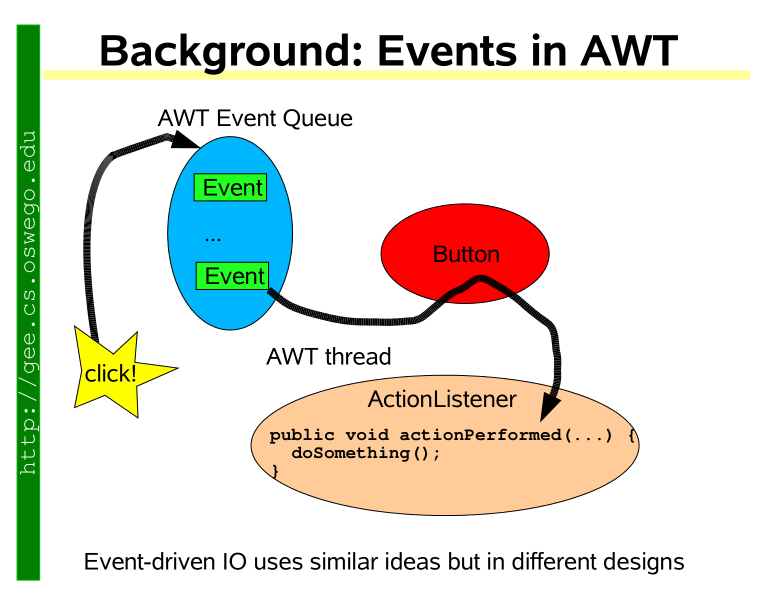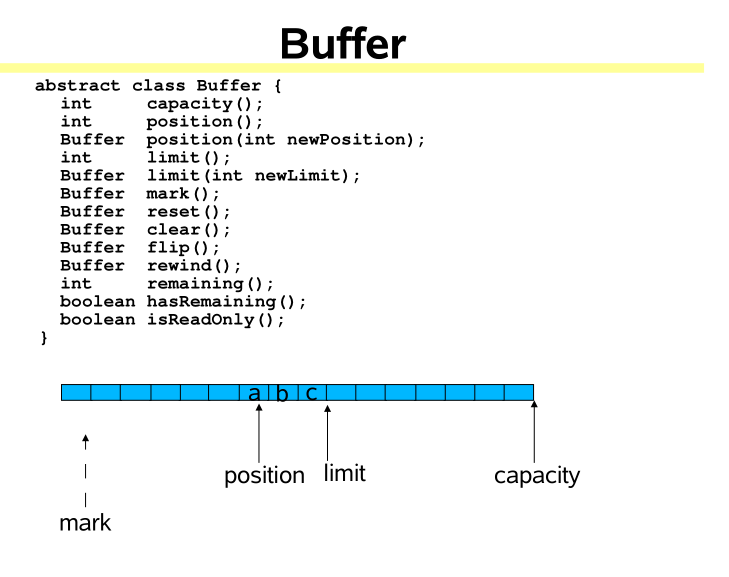java伸缩性io
文章目录
java伸缩性io
Scalable IO in Java
Outline(大纲)
- Scalable network services (伸缩的网络服务)
- Event-driven processing (事件驱动处理)
- Reactor pattern (反应器模式)
- Basic version (基础版本)
- Multithreaded versions (多线程版本)
- Other variants (其他变种)
- Walkthrough of java.nio nonblocking IO APIs (非阻塞IO的API)
Network Services (网络服务)
- Web services, Distributed Objects, etc (网络服务,分布式对象等)
- Most have same basic structure: (其他相似结构) Read request (读请求) Decode request (解码请求) Process service (处理服务) Encode reply (回复编码) Send reply (回复发送)
- But differ in nature and cost of each step XML parsing, File transfer, Web page generation, computational services… (但是 解析xml 文件转换 web页面生成 计算服务每一步的耗时是不同的)

Classic ServerSocket Loop (经典ServerSocker循环)
|
|
Scalability Goals(可伸缩性目标)
- Graceful degradation under increasing load (more clients) (在负载下的优雅降解)
- Continuous improvement with increasing resources (CPU, memory, disk, bandwidth)(通过增加资源而持续改进)
- Also meet availability and performance goals (同时满足可用性和性能目标) Short latencies (短延时) Meeting peak demand (满足高峰需求) Tunable quality of service(可调的服务质量)
- Divide-and-conquer is usually the best approach for achieving any scalability goal(分治法通常是实现可伸缩性目标的最佳方法)
Divide and Conquer (分而治之)
- Divide processing into small tasks Each task performs an action without blocking(将处理过程划分为小任务,每个任务执行一个操作,而不阻塞服务质量)
- Execute each task when it is enabled Here, an IO event usually serves as trigger(当这里启用每个任务时,IO事件通常充当触发器)

- Basic mechanisms supported in java.nio (支持nio基本的机制) - Non-blocking reads and writes (非阻塞读写) - Dispatch tasks associated with sensed IO events (分派与感知IO事件相关的任务)
- Endless variation possible A family of event-driven designs(无穷无尽的变化可能是一系列事件驱动的设计)
Event-driven Designs (事件驱动设计)
- Usually more efficient than alternatives Fewer resources(通常比替代能源更有效率资源更少)
- Don’t usually need a thread per client Less overhead(通常不需要一个线程,每个客户端更少的开销)
- Less context switching, often less locking But dispatching can be slower(更少的上下文切换,更少的锁定,但调度可能更慢)
- Must manually bind actions to events(必须手动将操作绑定到事件)
- Usually harder to program Must break up into simple non-blocking actions(通常更难编程必须分解为简单的非阻塞操作)
- Similar to GUI event-driven actions(类似于GUI事件驱动的操作)
- Cannot eliminate all blocking: GC, page faults, etc Must keep track of logical state of service(不能消除所有阻塞:GC、页面错误等必须跟踪服务的逻辑状态)

Reactor Pattern (反应器模式)
- Reactor responds to IO events by dispatching the appropriate handler(反应器通过调度适当的处理程序来响应IO事件)
- Similar to AWT thread(类似于AWT线程)
- Handlers perform non-blocking actions(处理程序执行非阻塞操作)
- Similar to AWT ActionListeners(类似于AWT actionlistener)
- Manage by binding handlers to events(通过将处理程序绑定到事件来管理)
- Similar to AWT addActionListener(类似于AWT actionlistener)
- See Schmidt et al, Pattern-Oriented Software Architecture, Volume 2 (POSA2)

java.nio Support
- Channels Connections to files, sockets etc that support non-blocking reads(连接到支持非阻塞读取的文件、套接字等)
- Buffers Array-like objects that can be directly read or written by Channels(可由通道直接读取或写入的类数组对象)
- Selectors Tell which of a set of Channels have IO events(告诉哪一组通道具有IO事件)
- SelectionKeys Maintain IO event status and bindings(维护IO事件状态和绑定)
Reactor 1: Setup
|
|
Reactor 2: Dispatch Loop
|
|
Reactor 3: Acceptor
|
|

Reactor 4: Handler setup
|
|
Reactor 5: Request handling
|
|
Per-State Handlers
|
|
Multithreaded Designs (多线程设计)
- Strategically add threads for scalability Mainly applicable to multiprocessors(策略性地添加线程以实现可伸缩性,主要适用于多处理器)
- Worker Threads (工作线程组)
- Reactors should quickly trigger handlers(反应堆应该能迅速触发处理器)
- Handler processing slows down Reactor(处理器处理减慢反应堆)
- Offload non-IO processing to other threads(到其他线程中卸载非io处理)
- Multiple Reactor Threads (工作反应器线程组)
- Reactor threads can saturate doing IO Distribute load to other reactors(反应堆线程可以饱和进行IO分配负载到其他反应堆)
- Load-balance to match CPU and IO rates(负载平衡,以匹配CPU和IO速率)
Worker Threads (工作线程组)
-Offload non-IO processing to speed up Reactor thread(卸载非io处理以加快反应堆线程) - Similar to POSA2 Proactor designs(类似于POSA2 Proactor设计) -Simpler than reworking compute-bound processing into event-driven form(比将计算绑定处理重新处理为事件驱动形式更简单) - Should still be pure nonblocking computation(仍然应该是纯非阻塞计算) -Enough processing to outweigh overhead(足够的处理超过开销) -But harder to overlap processing with IO(但很难与IO重叠处理) - Best when can first read all input into a buffer(最好能先将所有输入读入缓冲区) -Use thread pool so can tune and control (使用线程池以便进行调优和控制) - Normally need many fewer threads than clients(通常需要比客户机更少的线程)
Worker Thread Pools

Handler with Thread Pool (线程池处理)
|
|
Coordinating Tasks (协调任务)
- Handoffs
- Each task enables, triggers, or calls next one (每个任务启用、触发或调用下一个任务)
- Usually fastest but can be brittle(通常是最快的,但也可能很脆)
- Callbacks to per-handler dispatcher (对每个处理程序分派器的回调)
- Sets state, attachment, etc(设置状态、附件等)
- A variant of GoF Mediator pattern(一种GoF中介模式的变体)
- Queues
- For example, passing buffers across stages(例如,跨阶段传递缓冲区)
- Futures
- When each task produces a result(当每个任务产生一个结果时)
- Coordination layered on top of join or wait/notify(协调层在连接或等待/通知的顶部)
Using PooledExecutor (使用PooledExecutor)
- A tunable worker thread pool(可调工作线程池)
- Main method execute(Runnable r)
- Controls for:
- The kind of task queue (any Channel)(任务队列的类型)
- Maximum number of threads (最大线程数)
- Minimum number of threads (最小线程数)
- “Warm” versus on-demand threads (“温暖”与按需线程)
- Keep-alive interval until idle threads die to be later replaced by new ones if necessary(保持活动间隔,直到空闲线程死亡,如果必要的话,稍后将由新的线程替换)
- Saturation policy block, drop, producer-runs, etc(饱和策略块、降、生产者运行等)
Multiple Reactor Threads (多反应器线程策略)
- Using Reactor Pools (使用反应堆池)
- Use to match CPU and IO rates (用于匹配CPU和IO速率)
- Static or dynamic construction (静态或动态结构) Each with own Selector, Thread, dispatch loop (每个都有自己的选择器、线程、调度循环)
- Main acceptor distributes to other reactors(主受主向其他反应器分布)
|
|

Using other java.nio features
- Multiple Selectors per Reactor (每个反应器有多个选择器)
- To bind different handlers to different IO events(将不同的处理程序绑定到不同的IO事件)
- May need careful synchronization to coordinate (可能需要仔细的同步来协调)
- File transfer(文件转换)
- Automated file-to-net or net-to-file copying(自动文件到网络或网络到文件复制)
- Memory-mapped files(内存映射文件)
- Access files via buffers(通过缓冲区访问文件)
- Direct buffers(直接缓冲区)
- Can sometimes achieve zero-copy transfer(有时能实现零拷贝传输)
- But have setup and finalization overhead(但是有设置和终结开销)
- Best for applications with long-lived connections(最适合长时间连接的应用程序)
Connection-Based Extensions
- Instead of a single service request,
- Client connects
- Client sends a series of messages/requests
- Client disconnects
- Examples
- Databases and Transaction monitors
- Multi-participant games, chat, etc
- Can extend basic network service patterns
- Handle many relatively long-lived clients
- Track client and session state (including drops)
- Distribute services across multiple hosts
API Walkthrough
- Buffer
- ByteBuffer (CharBuffer, LongBuffer, etc not shown.)
- Channel
- SelectableChannel
- SocketChannel
- ServerSocketChannel
- FileChannel
- Selector
- SelectionKey

文章作者 gorpher
上次更新 2016-06-28